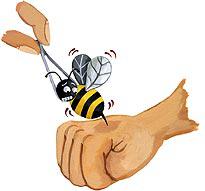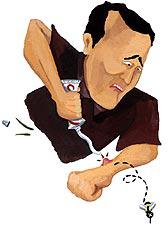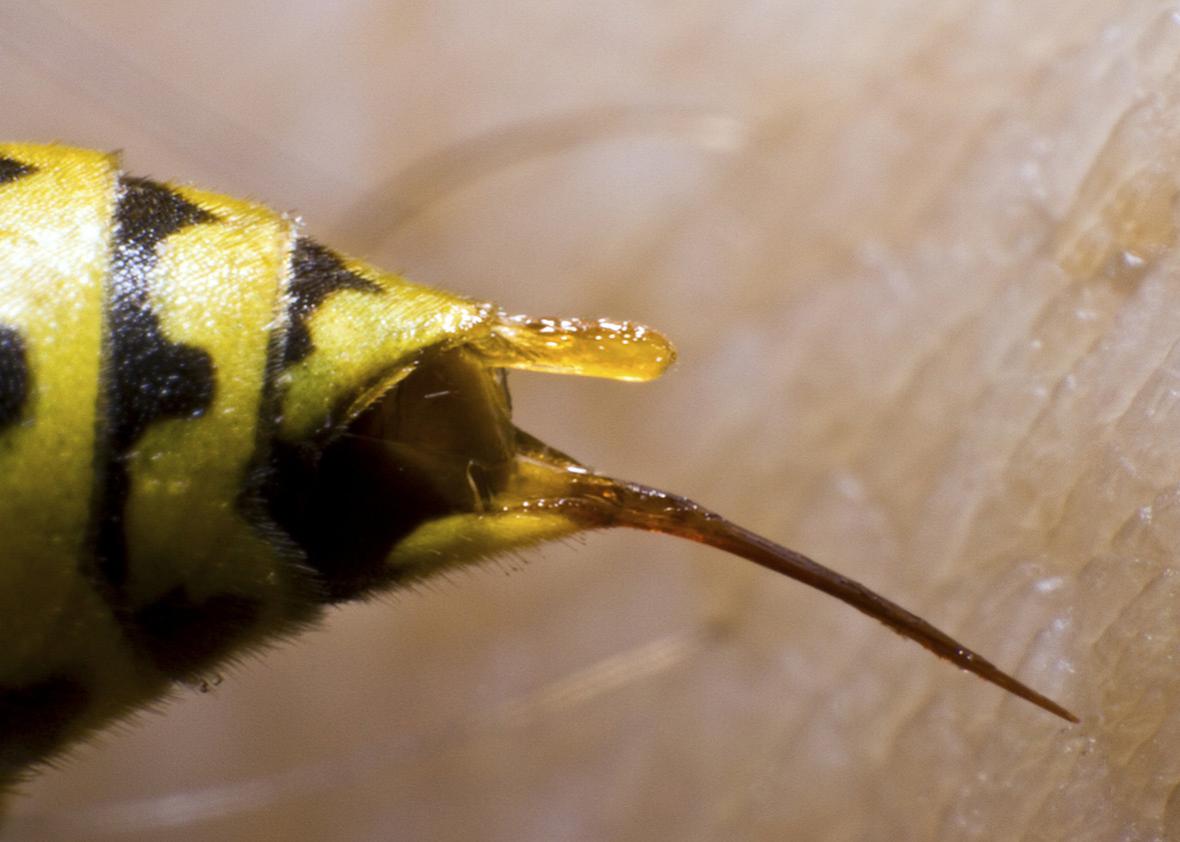When it comes to bee stings, most of us react somewhere between Smithers on The Simpsons—for whom one sting nearly meant death—and Jon Quinn, a beekeeper I visited recently, who was once stung more than 40 times and still had the wherewithal to count as he extracted the stingers. (Quinn’s decade and a half of beekeeping had desensitized him to the venom.) For most, a sting means aching and swelling accompanied by a maddening itch.
All of which I had forgotten until this past Fourth of July, when I was stung on the back of my arm. Surprised by the sudden pain, I slapped the bee off my arm, dug the stinger out, and went inside to ask for treatment advice. Everyone had a different answer. Ice! Tobacco! Benadryl! Butter! Ban Roll-On! I tried a handful but did so in such a haphazard way—sometimes applying two remedies at once—that I gave none of the remedies an opportunity to be effective. Or, if any were effective, I had no way of knowing which had worked. The symptoms finally died down after four and a half days, but the experience left me wondering: How exactly are you supposed to treat a bee sting? To find out, I went back for more.
The Remedies
First, I looked into treatments. I consulted mainstream medical manuals (signified, below, by “med”) published by Merck, Johns Hopkins, Harvard Medical School, the American Medical Association, and the Mayo Clinic. I thumbed through a stack of family-health guides like “Symptoms: Their Causes & Cures,” by the editors of Prevention (“diy”). I polled local beekeepers (“bee”), a few pediatricians ("doc”), a gaggle of pharmacists ("rex”), an entomologist in northwestern Massachusetts ("bug”), and my own family ("mom”). To track down more obscure home remedies, I poked around gardening and health Web sites ("web”). I decided to stay away from herbal soups that called for, say, a dram of lavender oil and a tablespoon of bentonite clay. (I assumed, maybe rashly, that most of you don’t stock a vial of lavender oil in the medicine cabinet.)
Once I had my arsenal of remedies, I was ready to be stung.
The Stings I visited Jon Quinn, the beekeeper who runs North Forty Apiaries, in Woodbury, Conn. Quinn held a bee with tweezers, shook it a little to anger it, and placed it over the area where I wanted to get stung. On my first trip, I received two stings, one on the top of each hand. Four days later, I returned for two more, which I took on the top of each forearm. A week later, I still had several remedies to test, so I went to another beekeeper (Quinn was out of town) and got another on my right hand. After each sting, I scraped out the stinger. All stings were equally painful and the symptoms developed at about the same rate.

Illustration by Nina Frenkel
I kept a running log of my symptoms—pain, swelling, and itching—quantifying the severity on a scale from 0 (asymptomatic) to 10 (severe). I logged a symptom score every half-hour, except while I was sleeping, of course. This allowed me to look back at the arc of relief each remedy provided (or failed to provide). I left the remedies on the sting areas for 25 minutes to 45 minutes (depending on suggested use), then (as gently as possible) cleaned the sting area. On average, I tested two remedies per day on each of the stings, spacing the applications at least five hours apart (a frequency based on the maximum number of times—three or four—you’re supposed to use an antihistamine or anti-itch cream in one 24-hour period). However, I used the remedies on an as-needed basis: If a remedy worked so well that the symptoms went away for longer than five hours, then I waited that long to apply the next remedy. I set my symptom score threshold at 7, the point at which symptoms became so severe that I had trouble concentrating on anything else. So if it had been at least five hours since I’d used the last remedy and my symptom score had returned to 7 or higher, then I knew it was time to apply the next remedy. Once a sting’s symptom score no longer returned to at least 7, I quit testing on that sting area. On average, I treated each sting for two and a half days.
Some of the remedies I came across were supposed to “cure” the sting, either by breaking down the toxins in the venom or suppressing the release of pain- and itch-causing agents in the blood. Other remedies were only supposed to “soothe” the sting by relieving the symptoms. I was interested in symptom relief, especially since the effects of a bee sting usually last only a few days and don’t pose any long-term problems. I judged the remedies on how well and for how long they relieved the swelling, pain, and itching. I also considered their appearance, aroma, ease of preparation, and price—though honestly, when it comes to bee sting remedies, all that really matters is what stops the itch.
I broke down the remedies into two groups: pharmaceutical remedies and home remedies (with their endorsers in parentheses). My findings, from worst to first:
Pharmaceutical Remedies
Worst
Skeeter Stik (endorsed by web), $1.99, and Survivor Gel Stick, $1.99.These two insect-bite/sting “relief sticks” contain benzocaine, the anesthetic that powers toothache medicines like Anbesol. Benzocaine deadens nerve endings, so that the symptoms aren’t transmitted to your brain. These remedies come in compact tubes that would be perfect to pack for fishing or camping trips. They would be perfect, that is, if they worked. The sticks immediately knocked Category 9 symptoms down to around 5. But a quarter of an hour later, the symptoms were back up to 9.
Ban Roll-On (endorsed by diy/doc), $2.99/1.5 ounces. This was endorsed by two pediatricians, though neither would speculate why it supposedly works and, say, Right Guard Sports Stick doesn’t. Both questions would be tempting to pursue … if the Ban had worked. Instead of soothing the itch, the Ban displaced it: A small circle around the sting was calmed, while the surrounding area surged to Level 8.

Illustration by Nina Frenkel
Bad
Benadryl Extra Strength Itch Stopping Cream (endorsed by med/diy/doc/rex/mom), $5.59/1 ounce. Antihistamines are supposed to work by suppressing the symptom-producing agents, called histamines, that are released in the body during an allergic response. After ice, Benadryl cream was the most-suggested remedy (though several of my sources—including a pediatrician—insisted that it was useless). It did decrease my symptoms from an 8 to a 5 for around 30 minutes. Benadryl also gets points for being nearly odorless and for drying invisibly, with no flaking. After one hour, though, my symptoms shot back up to 8, where they hovered until I used the next remedy.
Good
CVS Maximum Strength Hydrocortisone Cream (med/diy/doc), $3.29/1 ounce. The smell and consistency reminded me of kindergarten paste. The cream dried visibly white on the skin but reduced the symptoms from 8 to 5 for the first hour and kept them sub-7 for three more hours, at which point they bounced back to 8.
Excellent
Caladryl (med/diy/mom), $6.49/6 ounces. Calamine lotion with an analgesic, this pain- and itch-killer calmed my symptoms with a soothing tingle. I applied it while my symptoms were raging at 9, and, within 45 minutes, they had sunk to 2. Four hours later, the symptoms suddenly flared up to 10, but I found that I preferred this dramatic seesawing to the gradual return of symptoms I experienced after using other remedies. It felt honest, like the Caladryl was confessing, “OK, I’m done. Time for another dose.”
Home Remedies
Worst
Slice of raw white onion (diy/web), $1.49/pound. Of all the home remedies, the onion had the most stirring testimonials. (Even Ann Landers once passed the tip along in a column.) It was odd, then, that this was the only remedy that seemed to make my symptoms worse. I tried it twice, thinking that I had somehow—how though?—misapplied it. But both times I had similar deleterious results, and I was left trailing a pungent stink in my wake.
Tobacco (doc/mom/web), $5.03/pack Marlboro Lights, $5.79/can Skoal Long Cut Mint. I was pulling for the tobacco. It was even endorsed by the medical establishment. And of all the home remedies, it seemed the most likely to be available at outdoor parties and barbecues, where bee stings often happen (and where smokers are used to doling out cigarettes to moochers). I tried dampened tobacco from cigarettes as well as a few pinches of dip, and alas, neither affected the symptoms, which remained at 9 for the duration of my treatment.
Not Bad
Honey (moi), $5.50/1-pound jar of Jon Quinn’s honey. This was my own home remedy, and it seemed like an obvious one, since honey is a folkloric favorite for anything and everything. I thought maybe I’d stumble upon a great curative miracle—that a bee’s sting can be healed by its honey. No luck, but the cool and soothing honey did alleviate the symptoms (from 9 to 5) for 30 minutes, which was at least as good as several other remedies.
Excellent
Paste of vinegar/baking soda/meat tenderizer (diy/doc), $2.59/16.9 ounces vinegar, $2.79/2.25 ounces meat tenderizer. Due to the acid/base interaction of the vinegar and baking soda, the concoction fizzed like an Alka Seltzer on my arm. The symptoms raged on at Level 9 for the first 20 minutes but then began to subside. An hour later, the symptoms had gone down to Level 2, and they stayed that way for several hours. Chalk one up for the meat tenderizer, which contains papain, an enzyme found in papaya that supposedly breaks down the toxins in bee (and other) venom. (Though the meat tenderizer and vinegar made me smell like an antipasto sampler.)
Best
Toothpaste (diy/web), $3.99/tube Crest Advanced Cleaning. Like the Caladryl and meat tenderizer potion, the toothpaste tingled. This not only made it seem medicated, it felt like I was actually scratching the itch, which was both psychologically and physically satisfying. One doctor I spoke to suggested that the glycerin found in most toothpastes dries out the venom concentrated under the sting area. But several others I asked said the tingle was a result of the alkaline toothpaste neutralizing the acid in the bee’s venom. Either way, the toothpaste knocked Level 10 symptoms down to 0 in 15 minutes and held them below 7 for more than five hours, one of the only two remedies I tried that did so. The other was the winner of the experiment …
Ice (med/diy/doc/rex/bee/web/mom), universally cheap. Almost every source I checked mentioned ice as a top remedy. And they were all right. Ice works. A 20-minute application knocked out the symptoms almost immediately and kept them subdued for half the day. Ice reduces swelling by constricting vessels and slowing down the flow of venom-tainted blood. By numb force, it also cancels out pain and itching. Its flaw, of course, is its temperature; it can become uncomfortable without some kind of buffer wrapped around it (which, you know, is simple to do). Then again, ice is very easy to find and it’s also super cheap. You can even make your own with very little equipment.
Conclusion
So, how did the home remedies stack up against the pharmaceutical offerings? It depends on the home, I guess. The worst home remedies were worse than the worst pharmaceuticals, and the best home remedies better than the best pharmaceuticals. The Caladryl was the sole pharmaceutical remedy I’d use again. If I had to leave the house to go get it, though, I’d buy the meat tenderizer instead and use it in the vinegar/baking soda paste. Yet why bother with either of those when you already use, on a daily basis, the two best bee sting remedies? The winners: toothpaste and ice.
